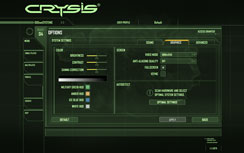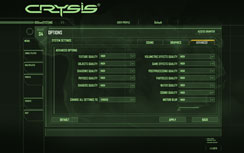Crysis
Publisher: Electronic ArtsWhat can we say about this game that hasn’t been said already? Crysis is probably the most anticipated game on the PC last year and was released on November 16th 2007.
Crysis is seen by many as the poster boy for DirectX 10 and it will make your system cry, quite literally – it’s a monster! It doesn’t come as much of a surprise then, that the graphics are something special – they’re above and beyond anything we’ve ever seen in a PC game.
We tested the game using the 64-bit executable under both DirectX 9.0 and DirectX 10 with the 1.2 patch applied. We used a custom timedemo recorded on the Harbor map which is more representative of gameplay than the built-in benchmark that renders things much faster than you're going to experience in game. We found that around 30-33 fps in our timedemo was sufficient enough to obtain a playable frame rate through the game. It's a little different to other games in that the low frame rates still appear to be quite smooth.
For our testing, we set Texture Detail, Shadows Quality, Physics Quality, Shaders Quality and Water Quality to High, while all other settings were set to medium. Because of how intense the game is, we tested with both anti-aliasing and anisotropic filtering disabled at resolutions above 1280x1024 for the time being. There is currently no support for anisotropic filtering in the game, but you can still force it from the driver control panel.
DirectX 10
DirectX 9.0
The Asus EAH3870 X2 coupled with the latest Catalyst 8.4 driver delivers no surprises under DirectX 10 mode – performance is roughly the same as it was with Catalyst 8.3 using a reference design 3870 X2. This means that Nvidia’s GeForce 9800 GTX is still a faster card when AA is enabled, but the 3870 X2 does hold its own when AA is disabled at higher resolutions. At 1,920 x 1,200, the EAH3870 X2 ends up about seven percent slower than the GeForce 9800 GX2 – that’s a pretty good result in its own right.
When you switch to DirectX 9.0 mode, however, there are some slightly bigger performance differences between the two driver revisions. They’re not massive by any stretch of the imagination, but we did see a two frames per second increase in the minimum frame rate at 1,920 x 1,200. Again, the card was slower than the GeForce 9800 GTX at lower resolutions when AA was applied, but then overtook it at the higher resolutions (albeit when AA was turned off).

MSI MPG Velox 100R Chassis Review
October 14 2021 | 15:04











Want to comment? Please log in.